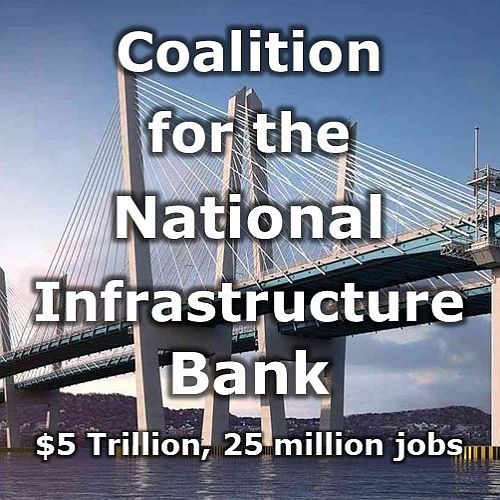Breakthrough Article Published On National Infrastructure Bank!

To Our Supporters:
Happy Holidays! On December 21, 2023, the Journal of Critical Infrastructure Policy (JCIP) published a 10-page feature article in their Fall Issue: National Infrastructure Bank: A Permanent Solution and Timely Budget Work-Around.
This article, submitted by Stanley Forczek, Coalition for a National Infrastructure Bank Advisory Board, is an important intervention into the national debate on economic policy. It openly promotes HR4052, the National Infrastructure Bank Act as the permanent solution to the Nation’s infrastructure crisis.
In their words, “JCIP provides a platform for researchers, policy makers and a range of professional groups.” JCIP publishes peer-reviewed articles and reaches a large cross-section of institutions involved in infrastructure policy.
Please share this article with friends and colleagues, and definitely with your member of Congress. We are actively seeking more cosponsors on HR4052.
You can also submit the article to other journals, newspapers, and infrastructure-related policy groups. If you are capable of getting this published, and need assistance, please reach out to the Coalition for a National Infrastructure Bank. You can contact Communications Director Angela Vullo. avullo@nibcoalition.com
Enjoy the Holiday, and please share this “present.”
Journal of Critical Infrastructure Policy • Volume 4, Number 1 • Fall 2023
December 21, 2023
National Infrastructure Bank:
A Permanent Solution and Timely Budget Work-Around
(excerpt)
The passage of time, chronic underinvestment, and climate change have left America’s public infrastructure dangerously overstretched and vulnerable. The bipartisan Infrastructure Investment and Jobs Act (IIJA) of 2021 provided billions of dollars in new Federal spending for infrastructure. While a significant start, the IIJA addressed only a small fraction of the nation’s current, unfunded needs. A $5 trillion National Infrastructure Bank, as proposed in HR4052, would fill that gap, provide technical/regulatory assistance, and turbocharge the American economy, with no need for added spending, taxes, or increases to the National Debt.
Legislation in Congress to Create a National Infrastructure Bank
As the United States grapples with the challenge of rebuilding its aging infrastructure, policy analysts agree that traditional methods may no longer suffice. The Council on Foreign Relations underscores this urgency, noting that despite the IIJA and related legislation, experts believe much more funding is required to overcome the country’s infrastructure deficit. Similarly, the National Governors Association has made a strong appeal to Congress for increased investment in water infrastructure, highlighting the critical needs for modernizing drinking and storm water systems. This raises a pivotal question: if the combined resources of federal and state budgets, along with private capital (as identified by CNIB in 2022), fall short, what alternative financing solutions can be tapped? As previously noted, addressing this gap is not just a matter of prudent policy but a crucial step towards ensuring sustainable and resilient infrastructure for future generations.
Congress is currently considering a groundbreaking legislative proposal (HR4052, as detailed on Congress.gov), aimed at revolutionizing America’s approach to infrastructure financing. This bill introduces the concept of a $5 trillion National Infrastructure Bank (NIB). Unlike traditional funding sources, the NIB, which would operate outside the national budget, represents an innovative solution to bypass the limitations of Federal and local budgets. As a federally incorporated entity (as per Wikipedia, Oct. 2023), the NIB would be uniquely capitalized by swapping existing private sector Treasuries for equity in the Bank.
This model isn’t new to American economic history. It mirrors successful precedents, such as the First Bank of the United States, established in 1791 by Treasury Secretary Alexander Hamilton (referenced in Wikipedia, Nov. 2023), and the Reconstruction Finance Corporation initiated under FDR (Butchiewicz). Like a commercial bank, the NIB would offer low-cost loans for specific infrastructure projects to entities in control of public infrastructure. The operating costs of the NIB would be minimal, requiring only a small initial appropriation from Congress (CNIB, 2021). This self-sustaining model would not only avoid adding to national deficits or debt but could provide an annual dividend payment to the government. This unique financial structure is designed to garner bipartisan support, reflecting the long-standing consensus that infrastructure development is a cross-party priority.
Conclusion
The stark reality highlighted in the 2014 “60 Minutes” documentary, America’s Crumbling Infrastructure, remains a pressing issue. Despite the clear and present danger posed by deteriorating infrastructure—from blocked ports and unstable bridges to regular electric outages and a critical housing shortage—effective solutions have been elusive. The IIJA and other recent outlays will have significant impact in this arena but does not contain sufficient financing to fundamentally improve the full range of inadequate or deteriorating infrastructures.
At this juncture, it is vital to ask: How can we finance comprehensive infrastructure that not only reach every American but also buttress our economy? Traditional approaches, limited by stretched Federal and state budgets—as well as insufficient interest from private capital markets —fall short. The answer may lie in innovative legislative solutions like HR4052, which proposes the establishment of a $5 trillion National Infrastructure Bank. This initiative is ambitious in scope and capable of addressing the entire financing gap. Moreover, it has a historical precedent, having been successfully implemented four times in U.S. history and emulated by other nations.
